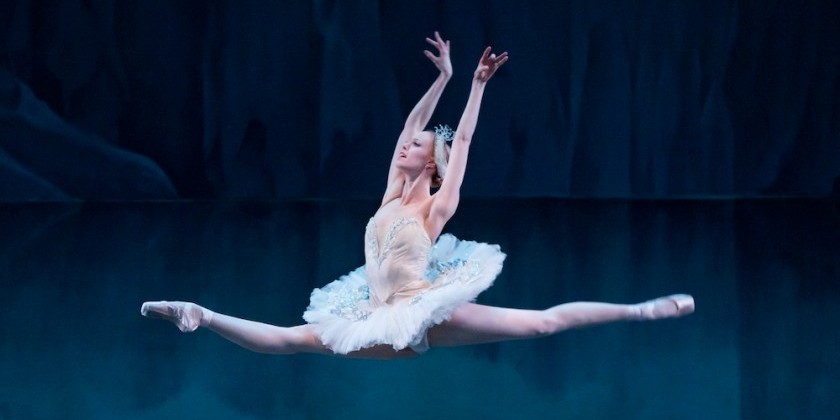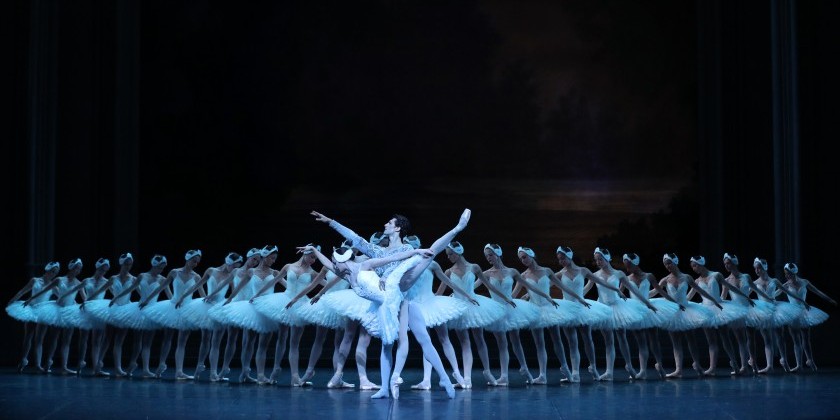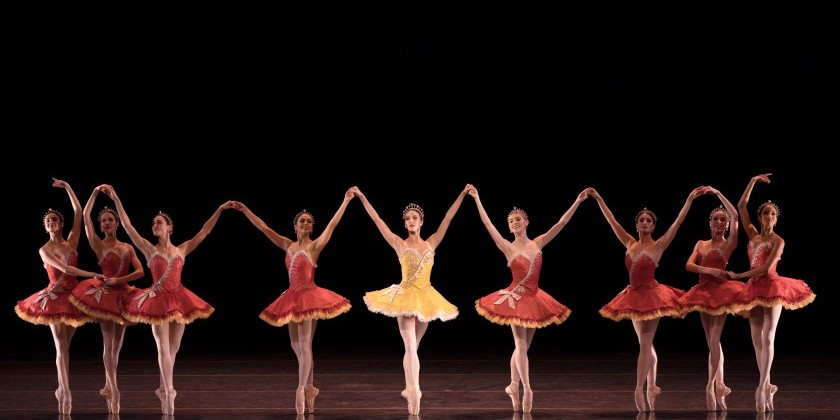Impressions of Justin Peck's “The Most Incredible Thing”

Based on the story by Hans Christian Andersen
Choreography by Justin Peck
Music by Bryce Dessner
Visuals/Costumes by Marcel Dzama
Lighting by Brandon Stirling Baker
Conductor: Andrew Litton
February 2 – May 7, 2016
David H. Koch Theater
“Dead men cannot walk the earth. That’s true, but a work of art does not die. Its shape may be shattered, but the spirit of art cannot be broken.” New York City Ballet Resident Choreographer Justin Peck cites this passage from Hans Christian Andersen’s 1870 story The Most Incredible Thing in the program notes for his new work. In interviews leading up to the ballet’s February 2 premiere, Peck emphasized that he wanted to stage Andersen’s story — which tells of a young, poor clockmaker who wins a princess and half a kingdom by building a magnificent clock with intricate moving figures — in a manner true not only to the story’s plot but to the tale’s emphasis on the enduring power of art and its celebration of craftsmanship. “I wanted this piece to have a real craftsmanship to it. …. I wanted it to feel handmade.”
Instead, I am sorry to report that The Most Incredible Thing shows an astonishing lack of craft from a choreographer who in the past has been reliably deft. Nearly all the previous works Peck has made for NYCB — this is his tenth work for the troupe, where he continues to dance as a soloist — have shown a good command of structure and an excellent command of how to move people around the stage. By contrast, in The Most Incredible Thing, he relies on a synopsis of Andersen’s story in the program to give the illusion of structure and action while his ballet rarely delivers on the action the synopsis outlines. A king proclaims he will hold a contest and ”whoever can do the most incredible thing is to receive the hand of the king’s daughter and half his kingdom.” Peck gives us Andersen’s clockmaker, who in the ballet is called The Creator (danced by Taylor Stanley), and a Princess (Sterling Hyltin), but they appear onstage and fall in love immediately, with no buildup to their meeting and no other contestants in sight. The mechanical figures of the clock come out to dance at each appointed hour, and the clockmaker is “named the winner.” Which is not surprising since he’s been the only one onstage vying for the prize. That is, until an interloper called the Destroyer, who has a large silver club in place of a right arm, enters to destroy the clockworks, an act that, he boasts, is truly “the most incredible thing.” (Amar Ramasar gleefully hurls his large, phallic club arm at the dancing clock figures.)

Struggling with the demands of telling a story through movement, Peck also has trouble with the even more basic task of moving his dancers around the stage. The only exception: two solos he creates for the Cuckoo, who appears out of the wondrous clock at the stroke of 1 and again at the stroke of 10. Tiler Peck (no relation to the choreographer) circuits the stage in bright leaps and turns, performing with her usual sparkling élan in a striking red-and-gold tutu with owl-like wings and an avian headdress. By contrast, the dances for the Creator and the Princess are static and formulaic, totally lacking in inspiration. Similarly, the series of dances Peck creates for the figures that emerge from the clock after the Cuckoo — Adam and Eve at 2, the Three Kings at 3, the Four Seasons at 4, and so on — unfold in the manner of a clotted pageant, in most cases with very little movement on view.
So The Most Incredible Thing fails as a demonstration of craftsmanship. It also fails as a demonstration of the eternal truth and importance of art. This ballet will not prove to be an enduring work of art. Whatever motivated Peck, his work is such a confused, over designed mash-up that I left the theater thinking that he either did not believe in the project or was totally overwhelmed by the task of making a narrative ballet with a large cast based on a story by a writer whose popularity in the late nineteenth century was on a par with that of Charles Dickens and whose works have been translated in 60 languages.
More disturbingly, the goal on the business side at NYCB was clearly never about creating a masterpiece but about producing a ballet capable of getting itself talked about and of luring a young “crossover crowd” from the art and rock music worlds. The main chatter accompanying the buildup to The Most Incredible Thing’s premiere was Peck’s collaboration with musician Bryce Dessner, a sometime-classical composer mostly known for being the guitarist of the Brooklyn-based indie rock band The National, and with hip visual artist Marcel Dzama. Dzama had never designed sets or costumes for a ballet before, but he has long incorporated figures frozen in ballet poses in his drawings: These often-masked, comic book-inspired people may come from his imagination, but the poses do not. In a recent interview, Dzama said he got the ideas for the ballet poses and groupings in his drawings mainly from photographs in dance magazines from the 1960s and 1970s.

Peck has described his collaboration with Dessner and Dzama as “an homage to the Ballets Russes days, when a designer with a visual arts background would come in and do the sets and costumes.” But there is nothing remotely like Diaghilev’s creative process to be seen in the history of the creation of The Most Incredible Thing. Diaghilev was a producer and a curator, who typically chose his designers and composers based on their rightness for the project at hand. Peck, Dessner and Dzama, on the other hand, had no idea what kind of ballet they wanted to do when they decided to team up. Peck has said it was because of Dzama’s highly theatrical, enigmatically narrative style that he settled on the idea of making a story ballet. The group then brainstormed for the right story, eventually choosing Andersen’s little-known, yet powerful and damning morality tale about the fragility of art, culture, religion, and ethics in the face of aggression and naked hunger for destruction.
Another way this artistic collaboration differs from the Ballets Russes model: Diaghilev was well known for demanding that the artists who worked for him raise the bar, famously saying to Jean Cocteau: Etonne-moi (“Astonish me.”). This story has been repeated so many times it now seems a tired cliché, but it wasn’t a throwaway remark — it was a challenge. According to Dzama, Peck’s instructions were: “I want you to do [the costumes and sets] in your style.” So the graphic artist created costumes with no regard for the dancers’ abilities to move. In addition, he inserted into his set designs “Dzamaland” motifs that have nothing whatsoever to do with Andersen’s tale.
The front curtain that we see during an initial orchestral overture includes signature Dzama motifs such as a devil-like creature at the top and the fires of hell at the bottom. A blood-colored maroon saturates the color palette. On the main backdrop featuring the wondrous clock — which, for Andersen was not only a metaphor for art and truth, but also spirituality and ethics — Dzama arrays, not numbers, but twelve figures encased in fawn-colored bodysuits embellished with white polka dots. Dzama calls these hooded figures in polka-dot-patterned clothing “pawns.” In his drawings, the hooded figures often carry guns or knives — even an axe wielded in midair, poised for a beheading. They are the Everyman Killer: jihadists from the Islamic State or al-Qaeda, maybe even the Ku Klux Klan (some sport cone-shaped hats over their polka-dotted robes). Nothing could be more antithetical to everything the clock represents than the violence conjured by these figures. (The polka-dot pawns appear as well in the circus-like multimedia installation Dzama has foisted onto the Koch Theater Promenade, a project for which New York City Ballet paid him a separate, additional fee.)

For the new ballet’s costumes, Dzama turned, as is his wont, to an earlier artist for ideas. Here, his “inspirations” (read: “source material free for the appropriating”) are the costumes by German Bauhaus artist Oskar Schlemmer for a 1922 dance called Triadic Ballet. Some of his designs are outright rip-offs of Schlemmer’s, such as the Nine Muses’ smooth white tutus covered in a black swirling op-art line. The Destroyer’s club arm is also straight out of the Triadic Ballet. For the Five Senses, Dzama turns to an appropriated image that recurs throughout his drawings: The dancers are outfitted in floor-length silver sculpture-dresses with circular tiers of material in a whirligig shape recalling Vladimir Tatlin’s 1919 building design, Monument to the Third International. The five young women unlucky enough to be cast in this dance (two are company apprentices) can do nothing within their shiny straitjackets but shuffle their feet, twirl, and lift and retract their heads. So that is what Peck has them do.

As for Dessner’s score, on a first listening, it seems as uninspired as Peck’s choreography. Also like the choreography, it lacks any clear shape or sense of purposefulness. If there were recurring themes, I missed them — sometimes the music sounds Minimalist, with clear chugging rhythms, at other times the sounds mix in a vague cloud of instrumentation with no clear rhythmic direction. Again, the Cuckoo’s dance stands out as an exception: For her dances, Dessner’s score evokes a birdlike fluttering, but his instrumentation avoids the usual hackneyed flute twitterings.
According to a New York City Ballet spokesman, the total bill for Peck’s one-act, 45-minute ballet was about $1.3 million. Asked how that ranks among price tags for recent new ballets at NYCB, he said such an estimate is impossible given the company’s repertory nature, which requires fixed costs, but he “would be surprised” if The Most Incredible Thing had a larger budget “than those associated with mounting some of our full-length productions.”
Share Your Audience Review. Your Words Are Valuable to Dance.
Are you going to see this show, or have you seen it? Share "your" review here on The Dance Enthusiast. Your words are valuable. They help artists, educate audiences, and support the dance field in general. There is no need to be a professional critic. Just click through to our Audience Review Section and you will have the option to write free-form, or answer our helpful Enthusiast Review Questionnaire, or if you feel creative, even write a haiku review. So join the conversation.













